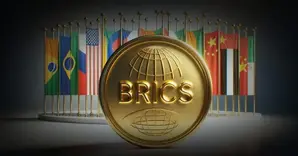US tariffs vs BRICS de-dollarization has become the defining economic battle of 2025, with President Trump’s recent threat to impose an additional 10% tariff on any nation aligning with “Anti-American policies of BRICS.” This escalation targets the growing BRICS de-dollarization push that’s been gaining momentum globally.
The China vs US trade war continues intensifying as BRICS cross-border payments systems challenge American financial dominance, while data shows clear signs of dollar dominance decline across global markets right now.
Also Read: BRICS vs NATO: Who Has More Military and Economic Power in 2025
How Tariffs, De-Dollarization & China’s Rise Reshape Global Finance

The Dollar’s Weakening Position
Dollar dominance decline has been accelerating, with the currency’s share of global reserves dropping to under 47% while gold now accounts for nearly 20% of central bank holdings. At the time of writing, IMF figures show the US dollar’s share in global foreign currency reserves fell to a record low of 57.8% by the end of 2024.
Central banks have been purchasing more than 244 metric tons of gold in the first quarter of 2025 alone, reflecting strategic moves away from dollar-denominated assets. The World Gold Council’s 2025 survey confirms this trend, with 95% of respondents expecting their gold holdings to continue increasing as the BRICS de-dollarization push gains traction.
Trump’s Aggressive Tariff Response
The US has actually implemented comprehensive tariffs targeting BRICS alignment rather than just trade imbalances. The effective tariff rate on most Chinese goods remains above 30%, while South Africa faces a 30% tariff. Countries like Malaysia, Indonesia, Myanmar, and Laos are risking similar penalties if they don’t strike deals with Washington by August 1.
This represents a direct response to the growing momentum behind US tariffs vs BRICS de-dollarization strategies. Trump’s executive action extends “reciprocal” tariffs for most nations until August 1, with the conspicuous exception of China, highlighting how the China vs US trade war has become the central battleground.
BRICS Payment Revolution
BRICS cross-border payments have been making significant progress, with bilateral trade between Russia and China now being conducted over 90% in rubles and yuan. This effectively bypasses dollar-denominated transactions and represents a direct challenge to US financial control.
The BRICS Cross-Border Payments Initiative, designed to rival SWIFT, shows growing ambition to insulate member economies from dollar-based disruptions. At the recently concluded 17th BRICS summit in Rio de Janeiro, leaders formally decided to advance this payment initiative as part of their broader strategy.
China’s Economic Leadership
China accounts for nearly half of BRICS GDP at 19.6%, with 70% of Brazil’s BRICS exports going to China. This asymmetry shows that the China vs US trade war primarily involves Chinese influence rather than true multipolarity within BRICS.
China’s control extends to rare earth elements, essential for manufacturing everything from smartphones to advanced military technology. This gives Beijing significant leverage in the ongoing economic confrontation, even as BRICS cross-border payments systems develop alternatives to Western financial infrastructure.
Future Market Implications
The current battle between US tariffs vs BRICS de-dollarization will likely determine the future structure of global finance. BRICS countries have no unified response to US tariffs yet, but their coordinated efforts on payment systems show potential for challenging American economic hegemony.
Also Read: The Mighty BRICS Folds Under Pressure
Until there is actually a truly credible alternative currency that is liquid, convertible, and backed by robust independent institutions, complete dollar dominance decline remains unlikely. However, the gradual shift toward alternative systems suggests that the traditional unipolar order is being tested as never before, with the BRICS de-dollarization push continuing to gain momentum globally.






